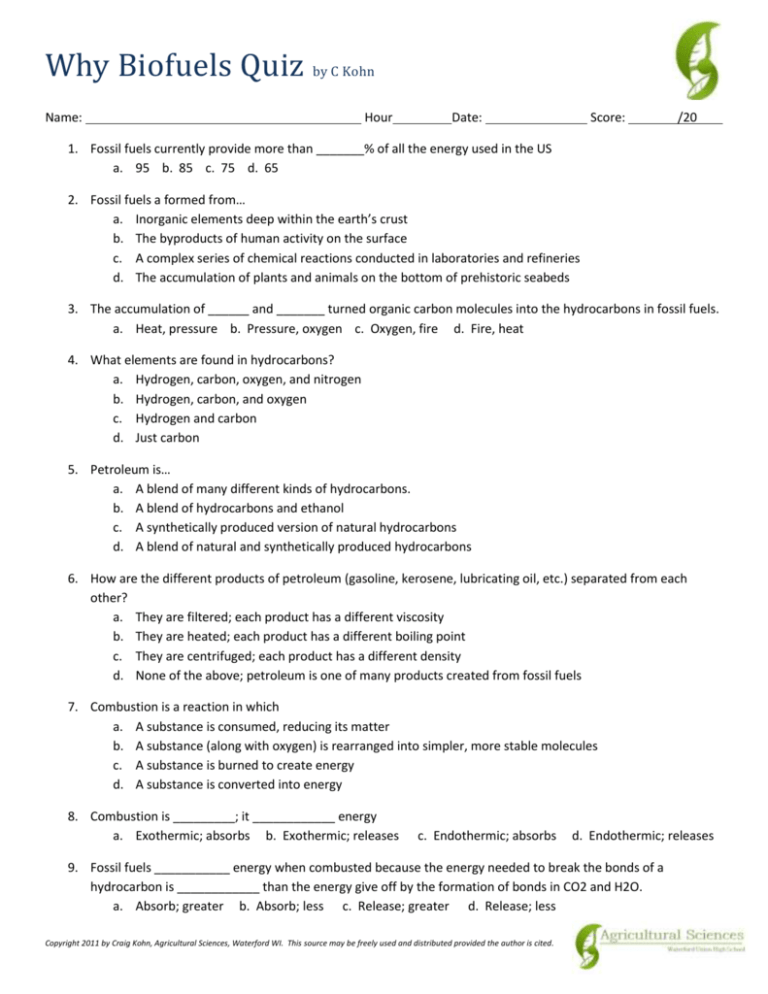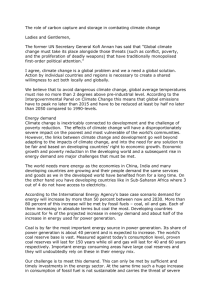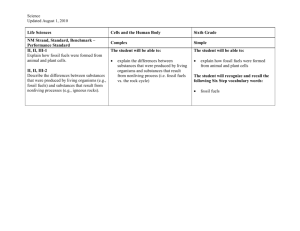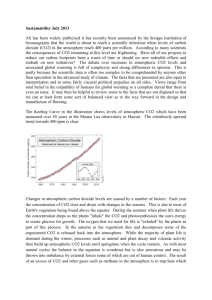Quiz
advertisement

Why Biofuels Quiz by C Kohn Name: Hour Date: Score: /20 1. Fossil fuels currently provide more than _______% of all the energy used in the US a. 95 b. 85 c. 75 d. 65 2. Fossil fuels a formed from… a. Inorganic elements deep within the earth’s crust b. The byproducts of human activity on the surface c. A complex series of chemical reactions conducted in laboratories and refineries d. The accumulation of plants and animals on the bottom of prehistoric seabeds 3. The accumulation of ______ and _______ turned organic carbon molecules into the hydrocarbons in fossil fuels. a. Heat, pressure b. Pressure, oxygen c. Oxygen, fire d. Fire, heat 4. What elements are found in hydrocarbons? a. Hydrogen, carbon, oxygen, and nitrogen b. Hydrogen, carbon, and oxygen c. Hydrogen and carbon d. Just carbon 5. Petroleum is… a. A blend of many different kinds of hydrocarbons. b. A blend of hydrocarbons and ethanol c. A synthetically produced version of natural hydrocarbons d. A blend of natural and synthetically produced hydrocarbons 6. How are the different products of petroleum (gasoline, kerosene, lubricating oil, etc.) separated from each other? a. They are filtered; each product has a different viscosity b. They are heated; each product has a different boiling point c. They are centrifuged; each product has a different density d. None of the above; petroleum is one of many products created from fossil fuels 7. Combustion is a reaction in which a. A substance is consumed, reducing its matter b. A substance (along with oxygen) is rearranged into simpler, more stable molecules c. A substance is burned to create energy d. A substance is converted into energy 8. Combustion is _________; it ____________ energy a. Exothermic; absorbs b. Exothermic; releases c. Endothermic; absorbs d. Endothermic; releases 9. Fossil fuels ___________ energy when combusted because the energy needed to break the bonds of a hydrocarbon is ____________ than the energy give off by the formation of bonds in CO2 and H2O. a. Absorb; greater b. Absorb; less c. Release; greater d. Release; less Copyright 2011 by Craig Kohn, Agricultural Sciences, Waterford WI. This source may be freely used and distributed provided the author is cited. 10. Enthalpy is… a. The energy from a reaction that is not available for use b. The energy emitted from a chemical reaction c. The creation of new energy from nothing d. A kind of reaction that absorbs energy from the environment 11. What is responsible for the smog, soot, and carbon monoxide associated with the use of fossil fuels? a. The hydrocarbon molecule – it cannot completely combust. b. The combustion reaction does not fully occur in most cases with hydrocarbons, leaving partial hydrocarbons that form these pollutants. c. The CO2 produced from the hydrocarbons prevents the combustion reaction from starting d. Fossil fuels are dirty because they come from the ground. 12. Biofuels tend to burn _________ than fossil fuels because they burn more _____________ a. Dirtier; slowly b. Cleaner; incompletely c. Dirtier; quickly d. Cleaner; completely 13. Why are atmospheric CO2 levels unnaturally high? a. CO2 is not naturally produced; human activity is adding this molecule to the atmosphere where it never once existed b. CO2 is in the atmosphere because of the hole in the ozone layer c. CO2 used to be produced and used in similar rates; the use of fossil fuels adds CO2 at a rate far faster than it can be reabsorbed d. CO2 levels are not a problem right now 14. How does CO2 cause changes to the Earth’s surface temperatures? a. CO2 absorbs and releases infrared radiation, holding it in the atmosphere longer b. CO2 forms a shield that traps radiation on the Earth permanently c. CO2 produces heat when it breaks down in the atmosphere d. CO2 does not cause an increase in surface temperatures 15. The US accounts for _________% of global carbon emissions despite having only _____% of the world’s population. a. 50; 25 b. 50; 5 c. 25; 10 d. 25; 5 16. Ethanol requires _____________ energy to produce than is released when it is combusted. a. Less b. More c. the same amount of 17. Ethanol produces ____________ carbon dioxide when it is combusted than gasoline. a. Less b. More c. the same amount of 18. A major disadvantage of ethanol is that it…. a. Has a lower gas mileage (vs. fossil fuels); b. Produces more CO2; c. Is less energy efficient; d. All of the above 19. Compared to petroleum diesel fuel, biodiesel is __________ burning, has ______ emissions, and is ______ toxic. a. Cleaner; lower; less b. Dirtier; higher; more c. Cleaner; lower; more 20. Biofuels are carbon neutral, meaning – a. They don’t produce CO2 b. They produce less CO2 than they absorb c. They produce more CO2 than they absorb d. They absorb the CO2 they release Copyright 2011 by Craig Kohn, Agricultural Sciences, Waterford WI. This source may be freely used and distributed provided the author is cited. Copyright 2011 by Craig Kohn, Agricultural Sciences, Waterford WI. This source may be freely used and distributed provided the author is cited.







